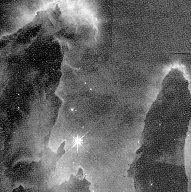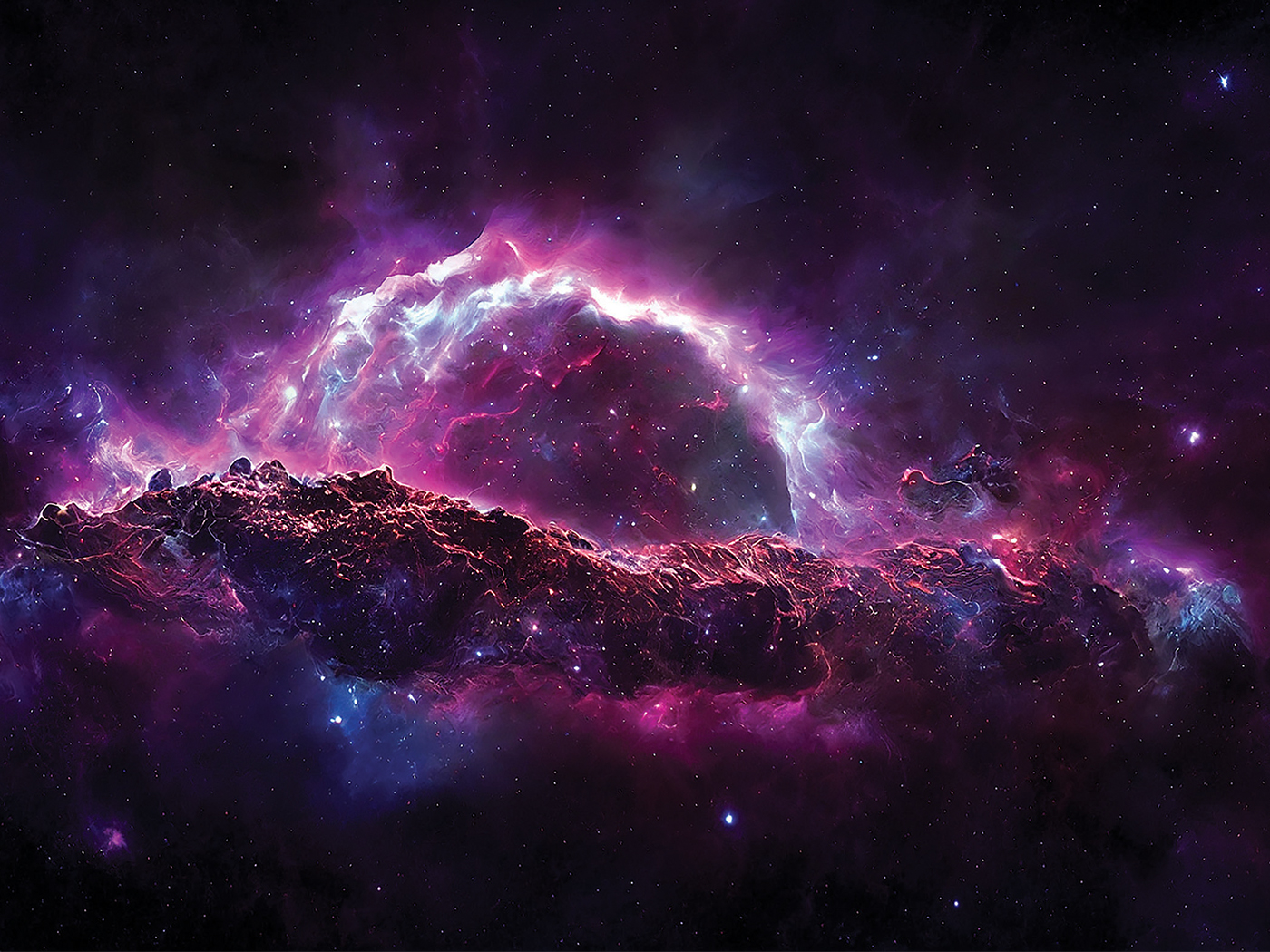Dramatic space pictures from the Hubble Telescope and other new instruments have become frequent news events. Everyone is awed by these colorful images of distant planets, stars, and galaxies. For the creationist, important questions arise: Are new stars forming today, as often reported? Are new planets which circle faraway stars beyond the solar system actually being discovered? Since our creation model is solidly in place, based on both science and Scripture, it is not threatened by new astronomical discoveries. Instead, publication of fresh data is welcomed since it helps us further refine the creation position.
Standard astronomy must assume that stars are continually forming in abundance throughout space. After all, the universe is thought to be ancient, and its stars are observed to die out sooner or later as novae or supernovae. Yet stars are still present in vast numbers, some "young" in age. If the universe is old, new stars must arise to maintain the stellar population. Even our sun is thought to have formed relatively recently in the history of the universe. For many years astronomy texts have been hard-pressed for evidence of new star formation.
 Figure 1. Photo of a small part of the Eagle Nebula, 7000 light years from earth. The pillars, several light years in size, consist of gas and dust. The stars at the tips of pillars are said to be newly formed. NASA
Figure 1. Photo of a small part of the Eagle Nebula, 7000 light years from earth. The pillars, several light years in size, consist of gas and dust. The stars at the tips of pillars are said to be newly formed. NASA
In 1995, newborn stars were reported to be emerging from giant pillar-like structures of gas and dust in the Orion and Eagle Nebulae, both a few thousand light years from the earth.[1] Stars are thought to form inside the clouds after which their stellar winds of radiation slowly clear the region. A part of the beautiful Eagle Nebula is shown in figure 1. The Hubble Space Telescope will surely find many other equally fascinating regions in future years, because after all, at this time we know very little about the detailed structure of space. The complexity of space appears to be designed to get our attention and also to frustrate all natural origin theories.
Only on an evolutionary time scale can regions like the Eagle Nebula properly be called "star nurseries." In stellar evolution models hundreds of thousands of years are required for a dust cloud somehow to collapse and a new star to form. A variety of stars are known to exist, and dust clouds have now been discovered. The theory says that dust clouds collapse to become a star, but the process has not been observed.
One alternative creationist model is that the entire heavens were formed much as we see them currently. If Adam and Eve had had access to a telescope, their space view then would have been very similar to ours today. That is, the universe appears to have been formed in a fully functioning state in every sense, complete with stars in all their variety. This would include red giant and white dwarf stars, pulsars, and also dust clouds. In this view all the stars we see were created on the fourth day, just a few thousand years ago. In this creation model all stars are "new" stars.
Given unlimited time, might a star naturally form in space? Theoretically, the answer is a qualified "yes." If a vast cloud of gas and dust could somehow be squeezed inward to a critical size, gravity would stabilize it, and nuclear fusion reactions might then begin. The sun itself is a stable gaseous sphere, as is the planet Jupiter. The needed initial condensing of gas to the critical size, however, appears to be a rare event. Astronomers have looked far and wide for indications of cloud collapse, but as yet have not found any. On rare occasions it may occur, as perhaps in compact globules of gas. However, this slight possibility falls far short of explaining the existence of the myriads of existing stars, most of which are located light years apart and far from gaseous nebulae.
It should also be remembered that astronomers have no satisfying formation mechanism for the vast nebulae themselves, from which stars are assumed to grow spontaneously. To make the popular assumption that the gas and dust came from preexisting stars is simply to reason in a circle.
It is quite certain that only nine planets circle the sun, with Mercury and Pluto as inner and outer boundaries. But what about additional planets far beyond the solar system? Such objects circling other stars have long been sought by astronomers. They reason that the earth naturally condensed from a disk of gas and then later quickly blossomed with evolved life. If true, then this also should be happening in many other places in space. The search for evidence of planets outside the solar system is sometimes described as seeking the "Holy Grail," a much overused term in current astronomy. In the past, many experts have reported planets orbiting distant stars, only to retract their claims with embarrassment later.
Over the years, Barnard's Star, 61 Cygni, VB8B, and several other stars showed wobbles that were heralded as planet-caused. Each planet report was later debunked.[2]
In 1992, a planet was declared to be orbiting a nearby pulsar.[3] Variation in the light signal was later embarrassingly shown to be caused by the earth's own orbital motion instead of by a new planet.[4]
In recent months there has been a flurry of new planet reports. Computer and instrument improvements have greatly increased detection abilities. We will consider three stars that show evidence of having planetary companions. In each case, no actual planet has been seen. It is difficult enough to observe distant Pluto in our own solar system; the new planets under consideration are 500,000 times more distant than Pluto.
Astronomers look for small, regular variations in the Doppler shifts of light emitted by stars. Such changes indicate a back and forth "wobbling" of the star's motion, perhaps due to gravity effects from an unseen, orbiting planet. Analysis of the light signal also permits estimates of the planet's mass and orbital characteristics to be made.
51 Pegasi. This sun-like star is 45 light years (250 trillion miles) from the earth.[5] If a planet does indeed circle this star, it is nothing like the earth. The star's light signal indicates a companion that is 190 times heavier than the earth and 22 times closer to its star than the earth is to the sun. As a result, the planet's surface temperature probably exceeds 1300·C, hot enough to melt copper metal. The planet also poses additional challenges for astronomers. First of all, theorists have long assumed that planets spontaneously coalesce from a protoplanet disk of material surrounding a star. In such models it is doubtful that such a large planet could ever form so close to a star. Secondly, sun-like stars such as 51 Pegasi are thought to go through a "T Tauri" phase in their youth. During this time the star would be 100 times brighter than it is today and would blow off a massive stellar wind of radiation, enough to evaporate any nearby planet. Thus, according to stellar evolution, this new planet should not exist where it does.
70 Virginis. The announcement of a possible planet circling this star follows seven years of close observation.[6] The planet appears to be 2500 times heavier than the earth (eight times greater than Jupiter) and twice as close to its star as the earth is to the sun. The speculated planet could possibly have a warm temperature, which has led astronomers to speculate wildly about the possible presence of liquid water there. Time Magazine even carried the false caption, "Astronomers have detected water-bearing planets around nearby stars."[7] In truth, water has not been found beyond trace amounts anywhere else in our solar system, let alone on unseen, distant planets.
Why the emphasis on water when the presence of any chemicals on far-distant planets remains completely unknown? The persistent hope is that water might accommodate the origin and evolution of life elsewhere. The planet of 70 Virginis, however, presents a severe challenge to any thoughts of extraterrestrial life. The planet's large size would result in enormous surface gravity and pressure. Because of this, some suggest that the planet might have a moon which harbors life. The planet also seems to have a highly elliptical orbit, leading to uneven heating of itself and any moons.
Some astronomers do not believe new planets have been found at all.[8] Instead, the massive objects circling other stars may be brown dwarfs. These are sub-stars that lack sufficient mass to begin vigorous nuclear fusion.
47 Ursae Majoris. This star resides in the Big Dipper constellation. Its wobble reveals a companion that is 1000 times heavier than the earth. Like other massive planets, this companion of 47 Ursae Majoris is probably gaseous rather than solid. It is twice the earth-sun distance from its star, resulting in a possible low temperature of -100·C. The planets of our solar systems, however, have shown that distance from a star may be a poor indicator of temperature. Venus, for example, is farther from the sun than Mercury, yet it is much warmer, with a temperature of 500·C compared to Mercury's 125·C.
The major impetus for new planet discovery is the "Search for Extraterrestrial Intelligence" or SETI. After spending untold millions of tax dollars over 35 years with zero results, Congress stopped funding SETI projects in 1993. The search is being continued today with private funding. Thus far, though, the only message received from radio signals in space is random static.
Claims of discoveries are flooding in from the new generation of space instruments. These reports are often given an evolutional "spin," especially regarding new stars, planets, and origin theories. Creationists are encouraged to enjoy and study the new data and photographs. They should also be ready to separate the unneeded, anti-creation statements that often accompany these reports. Our enlarging view of creation shows a complex universe that completely frustrates any attempt to explain its origin or content by natural processes alone. The heavens clearly declare God's glory!
-
NASA, Office of Public Outreach, Hubble Space Telescope, via Internet, 1995.
-
MacRobert, A.M. and J. Rather, The Planet of 51 Pegasi, Sky and Telescope 91(1), 1995, pp. 38 40.
-
Bailes, M., A.G. Lyne, and S.L. Shemar, A planet orbiting the neutron star PSR1329-10, Nature 352(6333), 1991, pp. 311-313.
-
MacRobert, A.M., et al. op. cit., p. 40.
-
Mayor M. and D. Queloz, A Jupiter-mass companion to a solar-type star, Nature 378(6555), 1995, pp. 355-359.
-
Cowen, R., Two Extrasolar Planets May Hold Water, Science News 149(4), 1996, p. 52.
-
Lemonick, M.D., Searching for other worlds, Time 147(6), 1996, pp. 52-57.
-
Cowen, R., op. cit., p. 52.
* At time of publication, Don B. DeYoung, Ph.D. was Professor of Astro/Geophysics at the Institute for Creation Research.
Cite this article: DeYoung, D. B. 1996. New Stars, New Planets? Acts & Facts. 25 (4).
















